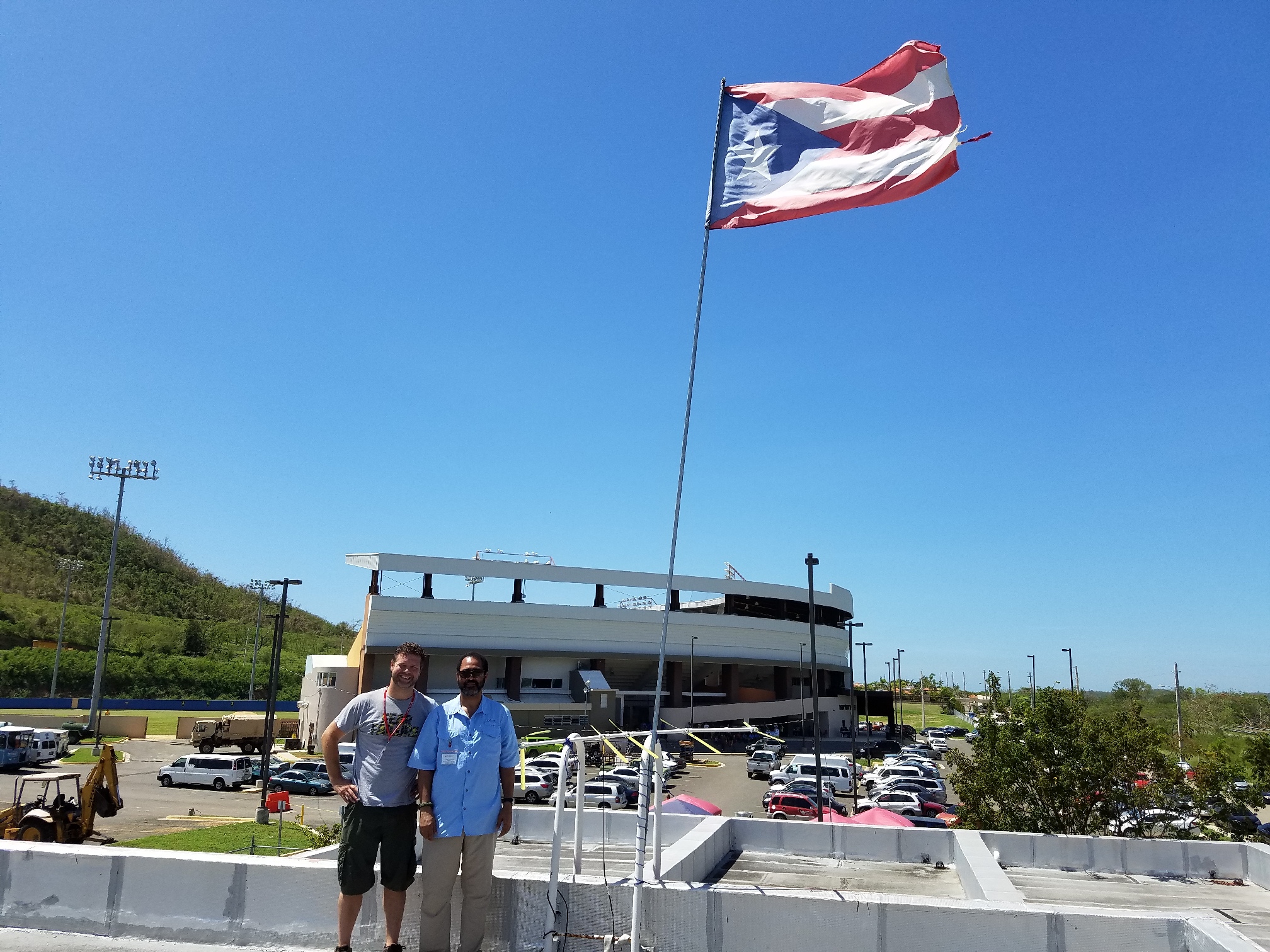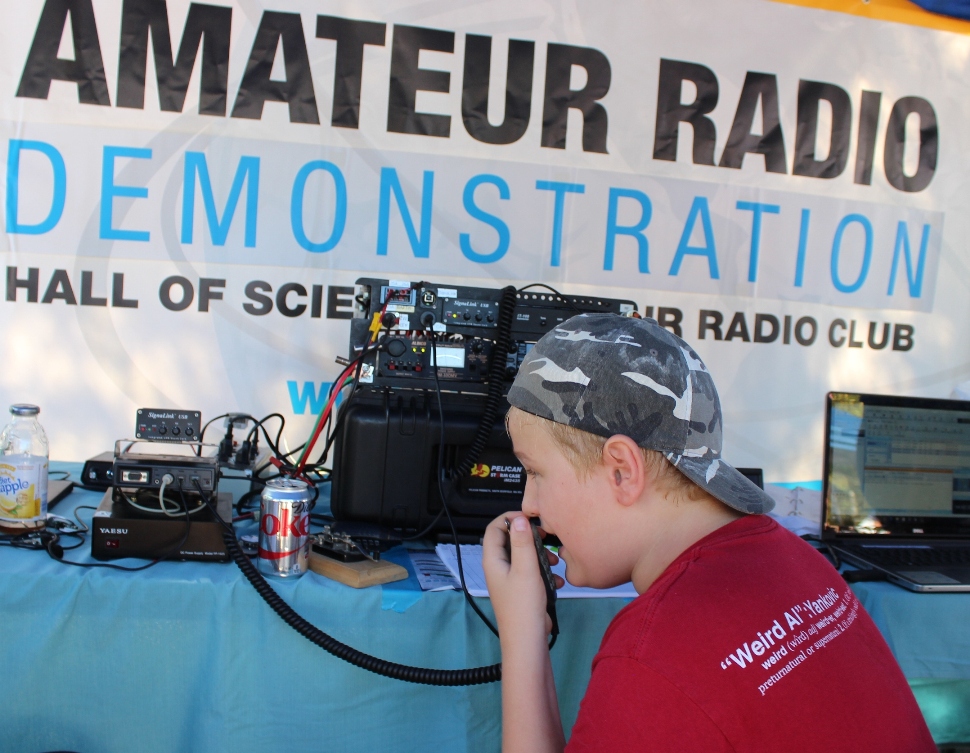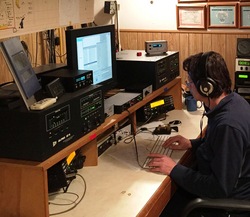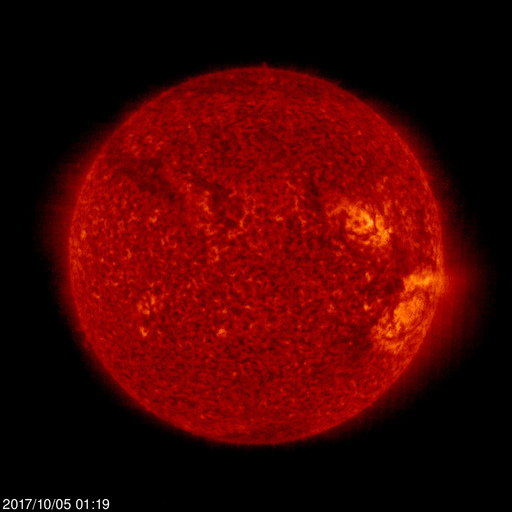 October 5, 2017 John E. Ross, KD8IDJ, Editor
| |||||||||||
Amateur Radio Volunteers in Puerto Rico Meet a Variety of Communication Needs The Amateur Radio volunteers who deployed as American Red Cross volunteers to Puerto Rico as part of the "Force of 50" this past weekend have been focusing their efforts where their help is most needed. ARRL CEO Tom Gallagher, NY2RF, said the volunteers, in general, will provide communications for local law enforcement and utility managers, island-to-mainland health-and-welfare traffic, and contact with the island's more remote areas.
Since the storm struck Puerto Rico on September 20, ARRL Section Manager Oscar Resto, KP4RF, and other volunteers have staffed VHF and HF nets at the American Red Cross temporary headquarters in San Juan, despite damage to their own homes. The 24/7 net covers nearly two-thirds of the island and has been handling traffic to and from the power company, Autoridad de Energía Eléctrica (Electric Power Authority -- AEE), and state and local authorities. The electric distribution infrastructure suffered extreme storm damage, and only about 9% of customers have power. Twelve team members were assigned to provide communication for engineers involved in repairing power distribution centers. An Amateur Radio station has been installed and an operator embedded at the Puerto Rico Emergency Operations Center (PREOC). Radio amateurs also were asked to establish VHF communication capabilities at 51 hospitals throughout the island, so they can have direct contact with the EOC.
Volunteer Val Hotzfeld, NV9L, told ARRL in an October 4 update that the team on the ground has recruited three local hams to handle Amateur Radio communications at hospitals in Jayuya, Humacau, and Caguas. "They were on site and began handling hospital traffic today," she said in her October 4 situation report. "We successfully received and forwarded traffic from three hospitals needing water and fuel."
Puerto Rico volunteers and local hams alike have successfully passed "lots of traffic" to net control, which has been forwarded on to the appropriate agencies. Some examples included getting an oxygen tank to a nursing home resident and insulin to a diabetic youth. A local radio amateur was recruited to handle hospital communications at Centro Medico. "This is the main hospital on the island and needs communication to handle transfers from the other hospitals and medical centers," she said. The Puerto Rico team has begun checking with hospitals to see which ones have telephone service, before dispatching additinal operators. Hotzfeld said they've received a request from AEE, which operates the precarious Guajataca hydroelectric dam, to deploy another operator to the dam and assist those fixing the channel that delivers water to about 350,000 in the Quebradilla and Isabella area. "We are now also being tasked with doing the same for all the police departments in Puerto Rico," she added. "We are gathering information on roads that are open from the EOC and providing it to the Red Cross for their missions." The Amateur Radio liaison at the EOC is working with federal officials to co-locate Amateur Radio repeaters on tower sites now being restored to improve communication island-wide. The volunteer team was approached by the Southern Baptist disaster team to discuss the possibility of utilizing a few of their team members who hams to help with communication tasks.
Volunteers Jeremy Dougherty, NS0S, and Bobby Price, KB4ROR, are in Yauco. "We installed our rigs in the fire truck and gave them our handhelds. It left us no other radio for local contact," the pair reported on October 3. They reached out to Marcos Pereda, KP3CA, in Yauco, who loaned the team his FTM-100DR. They didn't have an antenna that would offer sufficient range, so they improvised, fashioning a "tape measure" five-element Yagi, using supplies from a local hardware store and a coax jumper from their extra HF radio. "We installed everything and made contact with N5TGL and N0CSM, who are 50 miles away, [using] the repeater between us," they said.
There have been problems filling resource requests from remote areas of the island. A message was relayed on WinLink by Juan Sepulveda, KP3CR, from volunteer team members in Mayagüez on behalf of Lares Mayor Roberto Pagán, who had put out an urgent call for water for the town of some 5,000. According to one FEMA official, the White House situation room is extremely pleased and enthusiastic about the service Amateur Radio volunteers are providing in Puerto Rico. An HF station with Winlink capability and a VHF/UHF station have been set up in the FEMA disaster field office, and volunteers have been reporting in by radio from around the island to post situation reports. Four volunteers were positioned to accompany and provide VHF communication at Red Cross distribution centers on a daily basis. Two volunteers also were sent to Culebra Island to establish VHF and HF communication there, the first since the storm. FCC Grants Temporary Waiver to Permit Higher Symbol Rate Data Transmissions The FCC has granted an ARRL request to waive current Amateur Radio rules to permit data transmissions at a higher symbol rate than currently permitted, in order to facilitate hurricane relief communications between the continental US and Puerto Rico. The temporary waiver is limited to Amateur Radio operators in Puerto Rico using PACTOR 3 and PACTOR 4 emissions, and to those radio amateurs in the continental US who are directly involved with HF hurricane relief communications involving Puerto Rico or the US Virgin Islands, the Commission said.
ARRL explained in its waiver petition that it's shipping five PACTOR radio modems to Puerto Rico for use in connection with Hurricane Maria disaster relief communications. The League asked the FCC to temporarily allow PACTOR 3 and PACTOR 4 transmissions that exceed the current symbol rate limitations under § 97.307(f) of the Amateur Service rules. Under the current rules, "specified digital codes" in Part 97 may be used with a symbol rate that does not exceed 300 baud for frequencies below 28 MHz, with the exception of 60 meters, and 1200 baud in the 10 meter band. The baud rate limits were adopted in 1980, when the FCC amended Part 97 to specify ASCII as a permissible digital code. World Maker Faire Visitors Urged to Build, Make, Create, Communicate Ham radio exhibitors at the 2017 World Maker Faire in New York City over the September 23-24 weekend urged visitors to "build, make, create, communicate." Three Amateur Radio clubs took part in the event, held at the New York Hall of Science in Corona, Queens. World Maker Faire drew upward of 90,000 visitors in 2016.
An exhibit hosted by grade 6 to 12 students from the Garden School Amateur Radio Club (K2GSG) in Jackson Heights was aimed at introducing ham radio to those who stopped by. They also demonstrated electronics experiments, kit construction, and soldering skills. Projects included a Morse code practice oscillator and an LED candle. The Garden School ARC students are mentored by the Hall of Science Amateur Radio Club (WB2JSM/WB2ZZO), which co-exhibited at the World Maker Faire. Both are ARRL-affiliated clubs. "The Garden School students, led by their club advisor, science teacher John Hale, KD2LPM, did a great job engaging the public through kit building," said ARRL Marketing Manager Bob Inderbitzen, NQ1R, who was part of the ARRL contingent to the event. "They helped demonstrate the educational benefits of having students engaged in the STEM [science, technology, engineering, and math] disciplines. Garden School ARC was recognized with an Editor's Choice Blue Ribbon. Congratulations!"
Inderbitzen said the Hall of Science ARC worked hard to get people on the air. Their "Get On the Air" (GOTA) station paired attendees with experienced station operators to make VHF and HF radio contacts. Club trustee Steve Greenbaum, WB2KDG, helped to organize the joint exhibit with Garden School. A third group, HamHacks -- made up of high school and college students who enjoy hacking for ham radio -- also put in an appearance. Their projects include what they describe as "unconventional and cheap Amateur Radio hacks in Doppler radar, satellite photography, airplane tracking, microwave electronics, software-defined radios, and more." "HamHacks had a fantastic exhibit and team, showing off a whole lot of innovation," Inderbitzen remarked. "Their demonstrations included a WSPR (Weak Signal Propagation Reporter) software-controlled station, and an RF plasma generator. HamHacks contributed to the 'cool factor' with dynamic exhibits." ARRL CEO Tom Gallagher, NY2RF, also was on hand at the World Maker Faire to represent ARRL and to support the participating radio clubs. A 60-second video with highlights from the ham radio exhibits is posted on ARRL's Facebook page. The Doctor Will See You Now! "Soldering and Unsoldering" is the topic of the latest (September 28) episode of the "ARRL The Doctor is In" podcast. Listen...and learn!
Every 2 weeks, your host, QST Editor-in-Chief Steve Ford, WB8IMY, and the Doctor himself, Joel Hallas, W1ZR, will discuss a broad range of technical topics. You can also e-mail your questions to [email protected], and the Doctor may answer them in a future podcast. Enjoy "ARRL The Doctor is In" on Apple iTunes, or by using your iPhone or iPad podcast app (just search for "ARRL The Doctor is In"). You can also listen online at Blubrry, or at Stitcher (free registration required, or browse the site as a guest) and through the free Stitcher app for iOS, Kindle, or Android devices. If you've never listened to a podcast before, download our beginner's guide. US Senate Confirms FCC Chairman Ajit Pai for a Second Term In a generally party-line vote, the US Senate on October 2 confirmed FCC Chairman Ajit Pai for a second term on the Commission. Pai would have had to leave the FCC at the end of the year if he had not been reconfirmed.
President Donald Trump had nominated Pai for a new term in January; his previous term as a commissioner had expired on July 1, 2016, and his new term is retroactive to that date. FCC rules permitted him to remain until the end of 2016. The final Senate confirmation vote tally was 52-41, although he picked up votes from four Democratic senators. Pai has primarily drawn fire for his opposition to so-called "net neutrality" rules. All five members of the FCC must be confirmed by the Senate, but the president chooses which will serve as the chairman. IARU President: Traditional Aspects of Ham Radio May Not Be Attractive to Newcomers The 24th General Conference of International Amateur Radio Union Region 1 (IARU-R1) convened September 17-23 in Landshut, Germany, with representatives of 40 member-societies present and another 13 represented by proxy. IARU President Tim Ellam, VE6SH/G4HUA, welcomed the attendees, urging them to reflect upon what will attract the majority of young people into Amateur Radio, "and what our mutual expectations should be." Ellam said his personal observation is that, while some younger people are interested in the more traditional aspects of Amateur Radio, many are only interested in ham radio as an adjunct to other possibly unrelated interests.
"I applaud the excellent work that has been undertaken in this region through the Youngsters on the Air (YOTA) program." Tim said, crediting the hard work of IARU Region 1 Youth Working Group Chair Lisa Leenders, PA2LS. YOTA's summer Amateur Radio camps have attracted young hams from around the world; this year's was held in the UK. "Our ambition should be to embrace these individuals in their activities and accept that some of the more traditional aspects of the hobby will hold little interest to them, and, indeed, may no longer be relevant," he continued. "That is not to say that some are not enthused with what we all hold as the core of our hobby, such as contesting or operating generally. I fear, though, that we need to look at what will attract the new generations to Amateur Radio and make sure we promote Amateur Radio as meeting their needs, rather than promoting the historical view of what Amateur Radio has to offer."
Delegates to the plenary adopted a proposal that all IARU bodies and member-societies pressure national regulators to implement all recommendations that protect the amateur bands. They also approved initiating a simple noise-measuring campaign among Region 1 member-societies, giving IARU the ability to offer an independent opinion on the noise situation in the bands and trends over time. Region 1's highest recognition, the Roy Stevens, G2BVN, Memorial Trophy, was conferred upon Colin Thomas, G3PSM, for his outstanding contribution to Amateur Radio and the work of the IARU over several decades. The full Conference Report is available on the IARU Region 1 website. Read more. ARISS Moves One Step Closer to Flying New Amateur Radio Equipment to the ISS Amateur Radio on the International Space Station (ARISS) International Chair Frank Bauer, KA3HDO, announced this week that the program has submitted its Interoperable Radio System (IORS) flight-safety data package to NASA for review. ARISS has been developing the IORS to replace most of the Amateur Radio hardware now "This is a very major IORS milestone," Bauer said. "We cannot get [the new equipment] to orbit without successfully completing the safety review process and getting our hardware certified for flight." Bauer said having the work done by volunteers will shorten the timeline involved in getting the new Amateur Radio hardware to the ISS.
He explained that the material turned in for NASA Human Spaceflight Safety Certification covers the first three phases of a four-phase process. The initial steps in the process are aimed at ensuring that NASA understands the design, demonstrating that ARISS understands the potential hazards that the new hardware systems could introduce, and how it has mitigated or prevented them. The final phase will be complete when ARISS has finished all testing and NASA deems the hardware flight worthy. ARISS is hoping that will happen next spring.
"We will remove the 3 W Ericsson handheld radio system, initially certified for flight in 1999, and the packet module -- both of which have recently had issues," Bauer said, and install a brand-new, specially modified 25 W JVC Kenwood TM-D710GA radio to enable a multitude of new or improved capabilities on the ISS, including voice repeater and better APRS operations." A key development, Bauer explained, is the multi-voltage power supply (MVPS), which interfaces with multiple electrical outlet connector types on the station and provides a range of power-output capabilities for current and future ARISS operations and Amateur Radio experiments. ARISS invites contributions to help cover the expenses of its work. All donations go directly to ARISS. Read more. Amateur Radio Satellite Pioneer Patrick J. A. Gowen, G3IOR, SK Amateur Radio satellite pioneer Pat Gowen, G3IOR, of Norwich, England, died on August 17 after a lengthy illness. He was 85. "Pat was passionate about Amateur Radio, amateur satellites, and the environment; he contributed much over his long life to each of these and will be sadly missed," said AMSAT-UK Chair Martin Sweeting, G3YJO.
Gowen was the first radio amateur to work DXCC via low-Earth-orbit (LEO) satellites, although his award is #4, because he had to wait for QSLs to arrive. Fluent in Russian, he enjoyed conversing with the cosmonauts aboard the now-defunct Russian Mir space station and the ISS. Gowen also was the first to discover the resurrection of the long-dormant AO-7. He also was a prominent HF operator and DXer and a member of the First-Class CW Operators Club. A biochemist, Gowen was retired from the University of East Anglia. "No mention of Pat would be complete without noting his decades of work in cleaning up the beaches and waters of his beloved Norfolk," Ray Soifer, W2RS, commented. -- Thanks to AMSAT News Service In Brief...
The new chart is available as PDFs in these formats: 8.5 × 11 grayscale; 8.5 × 11 black and white; 8.5 × 11 color, and 11 × 17 color. The K7RA Solar Update Tad Cook, K7RA, Seattle, reports: For the past week, the 45-day outlook for solar flux and planetary A index from the US Air Force has been unavailable, with no updates since October 1. Over the past week (the 7 days through October 4), average daily sunspot numbers rose from 27 to 32.6, and the average daily solar flux rose from 84.3 to 87.9.
Because of the USAF outage, predictions for solar flux and planetary A index are now several days old. Predicted solar flux is 86 on October 5-6; 84 on October 7; 81 on October 8-9; 75, 74, and 73 on October 10-12; 72 on October 13-15; 71, 74, 73, 78, 80, 87, and 90 on October 16-22; 95 on October 23-November 2; 90, 85, 76, 75, 74, and 73 on November 3-8, and 72 on November 9-10. Predicted planetary A index is 5, 8, and 12 on October 5-7; 8, 8, and 5 on October 8-10; 25 on October 11-13; 20 and 15 on October 14-15; 8 on October 16-17; 5 on October 18-21; 16, 8, 20, 25, 20, 10, and 8 on October 22-28; 5 on October 29-November 6, and 25 on November 7-9. Sunspot numbers for September 28-October 4 were 40, 39, 38, 34, 25, 25, and 27, with a mean of 32.6. The 10.7-centimeter flux was 90.9, 89.7, 89.4, 85.7, 86, 86.4, and 87, with a mean of 87.9. Estimated planetary A indices were 55, 12, 16, 11, 7, 8, and 5, with a mean of 16.3. Estimated mid-latitude A indices were 41, 8, 11, 10, 6, 8, and 5, with a mean of 12.7. Send me your reports or observations. Just Ahead in Radiosport
See the ARRL Contest Calendar for more information. For in-depth reporting on Amateur Radio contesting, subscribe to The ARRL Contest Update via your ARRL member profile e-mail preferences. Upcoming ARRL Section, State, and Division Conventions
Find conventions and hamfests in your area.
. .
Subscribe to...
Free of charge to ARRL members...
Find ARRL on Facebook! Follow us on Twitter, Snapchat @ARRLHQ, and Instagram! | |||||||||||
 ARRL Emergency Preparedness Manager Mike Corey, KI1U, said arriving volunteers initially gathered at the Convention Center in San Juan, which is now serving as Puerto Rico Emergency Management Agency (PREMA) Headquarters. Their first night, a local church offered accommodations, he said, and volunteers slept on pews that had been pushed together.
ARRL Emergency Preparedness Manager Mike Corey, KI1U, said arriving volunteers initially gathered at the Convention Center in San Juan, which is now serving as Puerto Rico Emergency Management Agency (PREMA) Headquarters. Their first night, a local church offered accommodations, he said, and volunteers slept on pews that had been pushed together.



.jpg) "We conclude that granting the requested waiver is in the public interest," the FCC said in its October 5
"We conclude that granting the requested waiver is in the public interest," the FCC said in its October 5 

 Sponsored by
Sponsored by -th.jpg) "I am deeply grateful to the US Senate for confirming my nomination to serve a second term at the FCC and to President Trump for submitting that nomination to the Senate," Pai said in a statement. "Since January, the Commission has focused on bridging the digital divide, promoting innovation, protecting consumers and public safety, and making the FCC more open and transparent. With today's vote, I look forward to continuing to work with my colleagues to advance these critical priorities in the time to come."
"I am deeply grateful to the US Senate for confirming my nomination to serve a second term at the FCC and to President Trump for submitting that nomination to the Senate," Pai said in a statement. "Since January, the Commission has focused on bridging the digital divide, promoting innovation, protecting consumers and public safety, and making the FCC more open and transparent. With today's vote, I look forward to continuing to work with my colleagues to advance these critical priorities in the time to come."

 on the space station. It is called "interoperable" because it's designed to operate anywhere on the ISS. A NASA flight-safety review in about a month is the next step. Bauer said he was highlighting the accomplishment, because all work on the safety data submission was developed exclusively by ARISS volunteers, rather than NASA or other contractors, as had been done in the past. It also meant a substantial saving to ARISS, which has become more reliant on donations in recent years.
on the space station. It is called "interoperable" because it's designed to operate anywhere on the ISS. A NASA flight-safety review in about a month is the next step. Bauer said he was highlighting the accomplishment, because all work on the safety data submission was developed exclusively by ARISS volunteers, rather than NASA or other contractors, as had been done in the past. It also meant a substantial saving to ARISS, which has become more reliant on donations in recent years..jpeg)
.jpg)
 Gowen was a cofounder of AMSAT-UK and a member of its Board of Directors in 1974. He wrote the satellite column for Practical Wireless for many years and was a frequent contributor to The AMSAT Journal and OSCAR News.
Gowen was a cofounder of AMSAT-UK and a member of its Board of Directors in 1974. He wrote the satellite column for Practical Wireless for many years and was a frequent contributor to The AMSAT Journal and OSCAR News. ARRL Research Project Alert: ARRL has partnered with Readex Research to conduct a survey of both League members and nonmembers within the Amateur Radio community. Over the next several days, a select group of amateurs will receive e-mail invitations to participate. The survey will attempt to address the ways in which amateurs obtain their information, how local clubs serve their needs, and how ARRL might do a better job of providing helpful resources. Because of the way the survey methodology is designed, most amateurs will not receive an invitation, but if you're among the lucky few, we encourage you to say "yes!"
ARRL Research Project Alert: ARRL has partnered with Readex Research to conduct a survey of both League members and nonmembers within the Amateur Radio community. Over the next several days, a select group of amateurs will receive e-mail invitations to participate. The survey will attempt to address the ways in which amateurs obtain their information, how local clubs serve their needs, and how ARRL might do a better job of providing helpful resources. Because of the way the survey methodology is designed, most amateurs will not receive an invitation, but if you're among the lucky few, we encourage you to say "yes!" Update: Secure Forms on the ARRL Website: The security of your information on the
Update: Secure Forms on the ARRL Website: The security of your information on the  Clubs Active in ARRL Contest Club Competitions Should Review Eligibility Lists: ARRL Contest Branch Manager Bart Jahnke, W9JJ, suggests that now would be an opportune occasion to review
Clubs Active in ARRL Contest Club Competitions Should Review Eligibility Lists: ARRL Contest Branch Manager Bart Jahnke, W9JJ, suggests that now would be an opportune occasion to review .jpg) Revised ARRL Frequency Chart Now Available: An updated ARRL frequency chart is
Revised ARRL Frequency Chart Now Available: An updated ARRL frequency chart is  The average daily planetary A index bumped up from 9.9 to 16.3, and the average daily mid-latitude A index -- measured at a magnetometer at Wallops Island on Virginia's Eastern Shore -- increased from 7.6 to 12.7.
The average daily planetary A index bumped up from 9.9 to 16.3, and the average daily mid-latitude A index -- measured at a magnetometer at Wallops Island on Virginia's Eastern Shore -- increased from 7.6 to 12.7.







